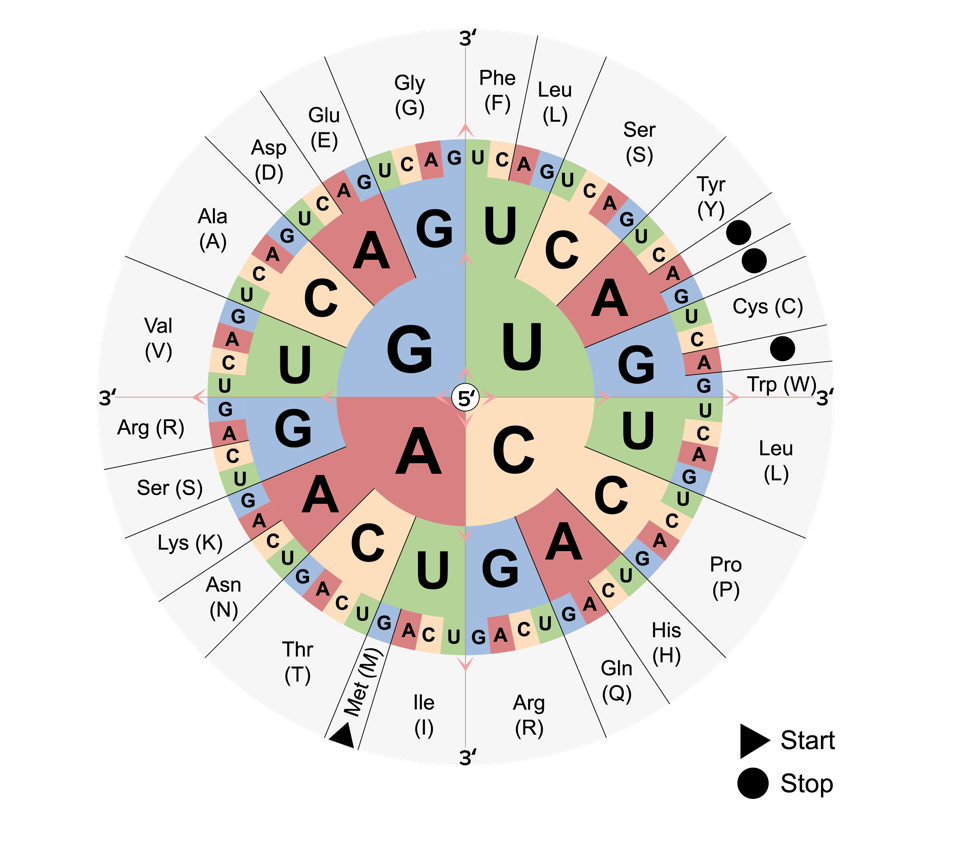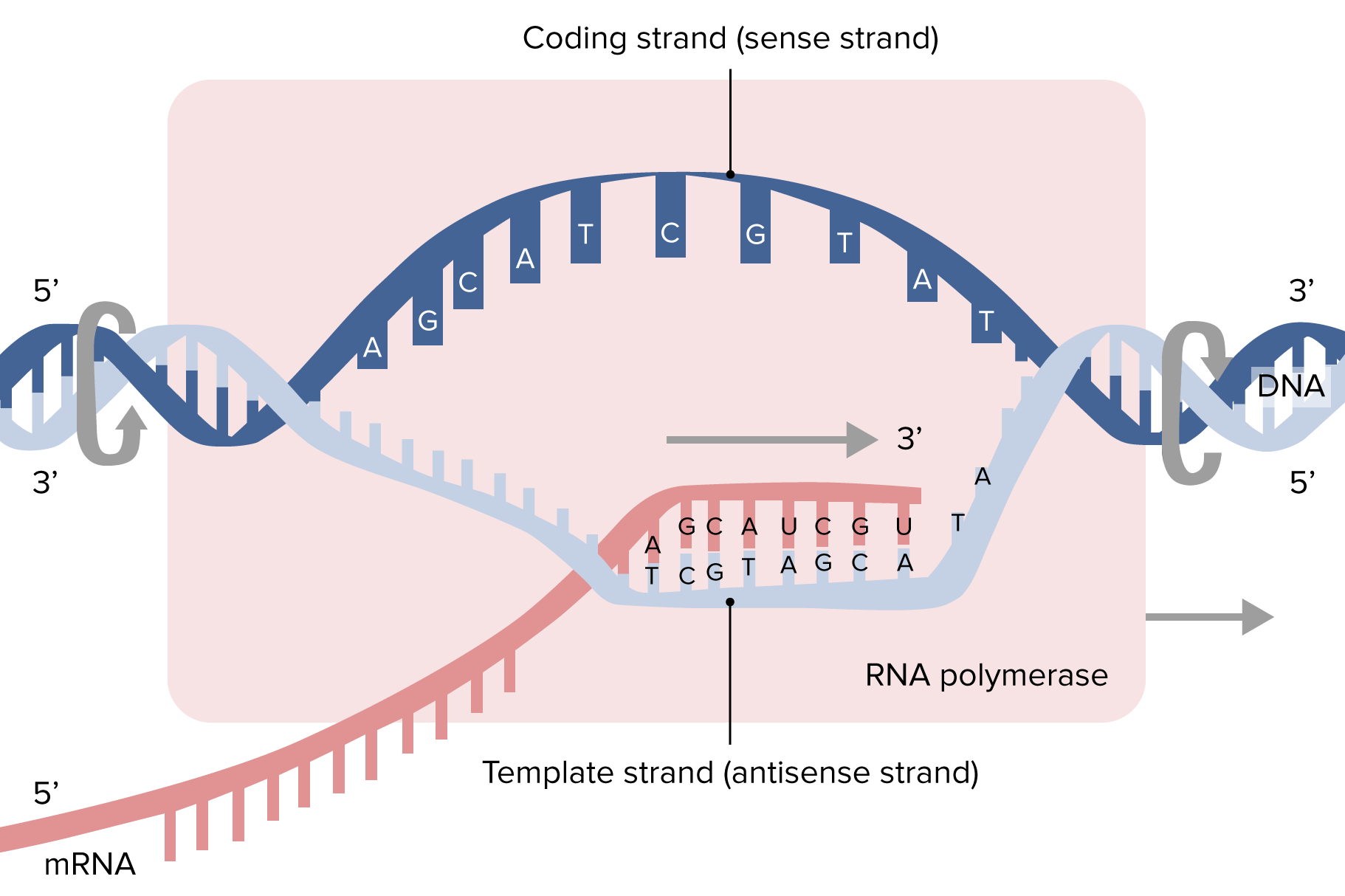Playlist
Show Playlist
Hide Playlist
Overview of Transcription and Translation
-
Slides 06 GeneExpression Genetics.pdf
-
Reference List Molecular and Cell Biology.pdf
-
Download Lecture Overview
00:00 Nun wollen wir einen kurzen Blick auf die Transkription werfen. 00:05 In einer zukünftigen Vorlesung werden wir dieses Thema vertiefen. Anschließend befassen wir uns kurz mit der Translation. 00:10 Glücklicherweise ist nur ein Enzym an der Transkription beteiligt. 00:19 Es wird RNA-Polymerase genannt und arbeitet ähnlich wie die DNA-Polymerase, fügt jedoch RNA-Nukleotide zur wachsenden Kette hinzu. Über diesen Transkriptionspparat müssen wir zunächst noch nicht alles wissen. Der DNA-Strang passt in den Apparat hinein. Wir öffnen eine kleines Fenster und synthetisieren eine RNA. Es gibt einerseits einen kodierenden Strang, der den genetischen Code enthält, und andererseits einen Matrizenstrang, der für die Synthese eines komplementären Stranges abgelesen wird. Die Sequenz des kodierenden Stranges entspricht somit der Sequenz der messenger-RNA. Die messenger-RNA wird freigesetzt und anschließend in ein Protein übersetzt. Das ist die Translation. Daran sind Ribosomen beteiligt. 01:16 Einige Ribosomen sind gebunden und andere frei im Zytosol. 01:21 Das Ribosom wird nach Bindung der messenger-RNA zusammengesetzt und es entsteht eine Polypeptidkette. 01:28 Die Basenabfolge der messenger-RNA wird in eine Aminosäuresequenz übersetzt. 01:37 Dafür sind Transfer-RNAs von Bedeutung. Transfer-RNAs oder Translations-RNAs transportieren die Aminosäuren für die Synthese der Polypeptidkette zum Ribosom. 01:51 Die Kette wächst bis Ende des Gens auf der messenger-RNA erreicht wird. 01:58 Dann fällt der gesamte Komplex auseinander. Der genetische Code wurde in ein Protein bzw. in eine Polypeptidkette übersetzt.
About the Lecture
The lecture Overview of Transcription and Translation by Georgina Cornwall, PhD is from the course Gene Expression.
Included Quiz Questions
Which of the following enzymes is responsible for DNA transcription?
- RNA polymerase
- Telomerase
- DNA polymerase
- DNA gyrase
- DNA primase
Which of the following components are needed to synthesize a polypeptide chain?
- Ribosomes, tRNAs, mRNA, and amino acids
- Ribosomes, helicase, mRNA, and amino acids
- Primase, tRNAs, mRNA, and amino acids
- Ribosomes, tRNAs, telomerase, and amino acids
- Ribosomes, tRNAs, mRNA, and reverse transcriptase
Customer reviews
2,1 of 5 stars
| 5 Stars |
|
2 |
| 4 Stars |
|
0 |
| 3 Stars |
|
0 |
| 2 Stars |
|
0 |
| 1 Star |
|
5 |
I like how she breaks down the information in small and easy to understand pieces. There's no need to overcomplicate things like other science teachers love to do.
I appreciate the approach to clear concepts and road map to the subject matter.
A student could do this lecture and it would be easier to understand. we expect better lectures from professors.
This topic is OVERLY simplified. It needs more in-depth explaination, which she claimed to offer later. But this brief section creates even more confusion... Maybe it is better to do a PROPER introduction, or just cut this one out... Also, she herself seems to be unsure and confused. I am not sure what her profession is, but DNA doesn't seem to be a topic, which she should lecture on... In the middle of the video she just blanked, and kind of skipped on some points... (That's not the first time or first lecture that she does that...) P.S. The powerpoint is also not accurate... The coding strand around 0:52 is indicated as template strand... This lecture is quite disappointing, and frankly, a very low quality compare to other Lecturio's lectures.





